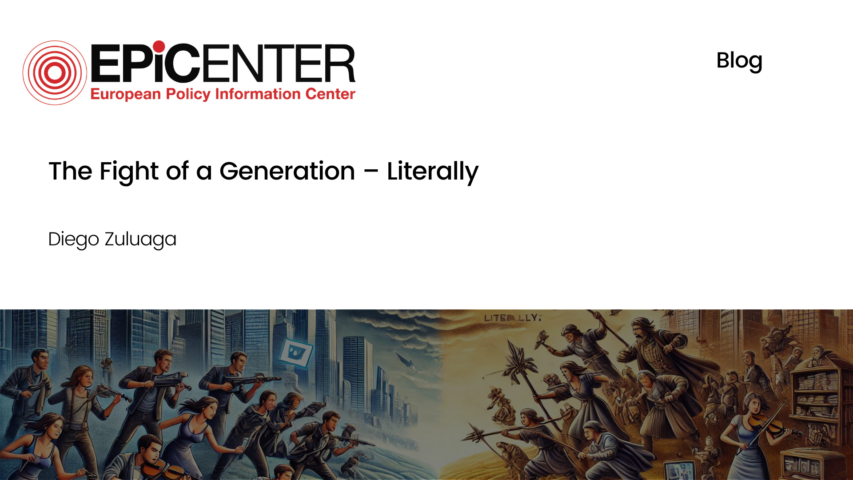The Fight of a Generation – Literally

The Fight of a Generation – Literally
Diego Zuluaga // 21.09.2016
Economic debates are often presented as a contest between two opposing interest groups. Marxian socialism pitted capital against labour. Some variation of this cleavage – rich vs poor, the one per cent vs the 99 per cent, developed vs developing countries – remains popular among much of the political Left in Europe and North America. Protectionists, whether of the nineteenth century mercantilist variety or of more recent Trumpian coinage, set the dividing line between natives and foreigners, domestic goods against imports, trade surpluses versus trade deficits.
Both of these narratives share a view of the economy as wholly or partly a zero-sum game. Liberals and libertarians counter that such an analysis is fundamentally flawed: since 1800, GDP per capita in Western Europe, the United States and other industrial economies has grown 20- to 30-fold. Other continents took much longer to develop, but have done so at impressive rates in recent years: in Latin America, income per head is four times higher today than in 1930; in Asia, it is eight times greater than in 1951. Bear in mind that the average is brought down by humanitarian disasters such as North Korea, 1970s Cambodia and – latterly – Venezuela.
The historical record thus belies the account of economic life as a win-lose proposition, whether between or within countries. Only last week, a report by the poverty charity the Resolution Foundation questioned the oft-repeated claim that the last three decades of globalisation had benefitted poorer countries but come at the expense of the working and middle classes of developed economies. This claim is often made in connection with the ‘elephant curve’ posited by World Bank economists Christoph Lakner and Branko Milanovic, which shows incomes stagnating between 1988 and 2008 for the 80th to 90th percentiles of the global income distribution. In the wake of Lakner and MIlanovic’s paper, commentators had identified these income groups as those left behind by globalisation: the lower middle class in Europe and North America, who are now turning their backs on free trade and electing populist politicians.
The researchers at the Resolution Foundation found that, once the data is adjusted for population growth in poorer countries and demographic decline in richer ones, and if Japan and the post-communist states of Eastern Europe – as well as booming China – are excluded, the elephant shape disappears. We are left instead with a remarkably even distribution of income gains across the spectrum.
The argument that there is a horizontal divide between rich and poor – whether at the national or the global level – becomes less compelling. Instead, some argue that the real split is vertical, separating the politically connected from those who are not. This divide may be correlated with differences in income – especially over the long run as those with political influence make use of it to redistribute resources – but it may not be. It is not a split according to wealth, purchasing power or property, but on the basis of access to legal privileges, taxpayer funds and other outputs of the political process.
For instance, many developed countries operate subsidy schemes for the agricultural sector. These are usually paid for out of general tax revenues. The basis for this redistribution is not an income differential between farmers and non-farmers – rather, it is a product of the strong influence and concentrated interests of the farming sector, against the diffuse interests and weak incentives for action among the general population. A similar reasoning can explain closed shops in the taxi, pharmacy and notary trades, and, more generally, strict licensing provisions and high minimum wages in many jurisdictions.
In contrast to free exchange, which economic theory and historical evidence show to lead to positive-sum outcomes, legally sanctioned privileges benefit certain groups only at the expense of others. Targeted subsidies are financed by taxpayers at large, monopolistic rents are paid by consumers and the cost of licenses borne by those who cannot enter the trade, and so on. There is no free lunch when it comes to government-granted privilege.
For most of the 19th and 20th centuries, state-sponsored privilege drove a wedge between insiders and outsiders according to individual characteristics such as occupation, nationality, professional qualifications, and family origin: skilled vs unskilled workers, farmers vs industrial workers, organised vs unorganised labour, natives vs immigrants, domestic firms vs importers, and so on. However, increasingly across much of the West, the split is most pronounced between generations. Specifically, the old have secured a range of state-sanctioned benefits at the expense of the young.
Such intergenerational inequity comes in many guises. For instance, planning restrictions in Britain have pushed median housing prices to five times median incomes – and nine times in London – very much higher than the standard 2-to-3 multiple in most developed countries. Price increases have overwhelmingly benefitted the well-housed over-50s – whose wealth has grown apace – but they have made rents more expensive – and home ownership less affordable – for the under-40s.
All across the EU, there are large differences in the unemployment rate of young people compared to the labour force at large. Figures close to 50 per cent in Spain and Greece tend to make headlines, but it is equally true that joblessness among those 25 and under is more than three times the general rate in France, Poland, the Czech Republic and Belgium, and four times in Sweden, Britain and Italy. Whilst some of the discrepancy may be explained by the post-crisis environment of low growth, a significant portion is structural. It can be attributed to labour-market regulations which make the hiring of new employees expensive, the dismissal of old employees difficult, and minimum wages often higher than the productivity of inexperienced workers. All of these features of European labour markets militate against the young.
Finally, there are the enormous pension commitments made by European governments in the context of broadly shrinking populations and rising life expectancy. A 2014 report by Jagadeesh Gokhale for the Institute of Economic Affairs found these commitments to reach as much as three to four times national income in some EU countries. The expenditure cuts or tax increases required to meet these promises in the absence of radical restructuring of pension and healthcare systems would see fiscal efforts more than double in the average Member State, or public spending significantly curbed.
Those of us who grew up in the Internet age have much to be grateful for. The average young person today is financially better off, safer, healthier and better educated than at any time in history. This is true for both developed and most developing countries. Yet, one of the curses of prosperity has been the growth in government-granted privileges, with the middle-aged and old as the main beneficiaries, and the young – sometimes even the unborn – left to pick up the tab. This trend is unsustainable even under the most optimistic forecasts for economic growth and demographic expansion.
Outgoing U.S. President Barack Obama has labelled inequality “the defining challenge of our time.” It may well be that his successor – whether man or woman – will make the end of globalisation the defining feature of their presidency. Yet, as claims about increasing inequity and the impact of free trade continue to be debunked, policymakers would do well to turn their attention to the growing gap between old and young. Therein lies arguably the most fundamental unaddressed challenge of our age.
Diego Zuluaga is Head of Research at EPICENTER.
EPICENTER publications and contributions from our member think tanks are designed to promote the discussion of economic issues and the role of markets in solving economic and social problems. As with all EPICENTER publications, the views expressed here are those of the author and not EPICENTER or its member think tanks (which have no corporate view).









